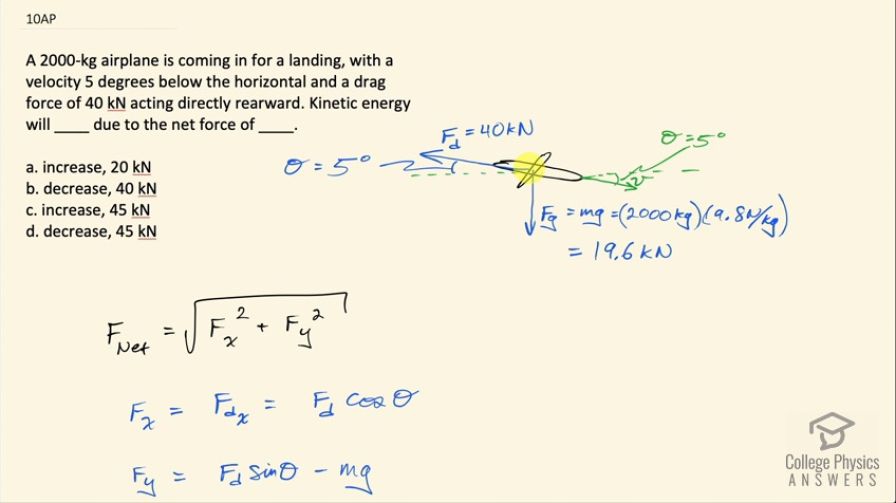Question
A 2000-kg airplane is coming in for a landing, with a velocity 5 degrees below the horizontal and a drag force of 40 kN acting directly rearward. Kinetic energy will ____ due to the net force of ____.
- increase, 20 kN
- decrease, 40 kN
- increase, 45 kN
- decrease, 45 kN
Final Answer
(d)
Solution video
OpenStax College Physics for AP® Courses, Chapter 7, Problem 10 (Test Prep for AP® Courses)

vote with a rating of
votes with an average rating of
.
Video Transcript
This is College Physics Answers with Shaun Dychko. A plane is coming in for landing with a velocity that's angled at 5 degrees below horizontal and the drag force is exactly opposite to the velocity and so it's 5 degrees above the horizontal to the left and the magnitude of the drag force is 40 kilonewtons we are told. The mass of the plane is 2000 kilograms and so the other force acting on it is gravity, which is straight down, equal to mass times gravitational field strength. So that's 2000 kilograms times 9.8 newtons per kilogram which is 19.6 kilonewtons. The question is asking what happens to the kinetic energy due to whatever net force? So the kinetic energy is clearly decreasing because there's a lot of drag force supposing the velocity and therefore slowing it down and so the answer is either (b) or (d) and so the next question is what is the net force? So we have two vectors that we have to find the resultant of and the net force is going to be the square root of the sum of the squares of the x-component and the y-component, total forces. So the x-component is the easy part because only one of these forces has any x-component and that's the drag force and its x-component will be this portion that's horizontal here so this is drag force x-component and it is the hypotenuse of this right triangle multiplied by cosine of this angle here. So the drag force times cos Θ is the total x-component of the resultant. The y-component of the resultant is the y-component of the drag force, which is this hypotenuse multiplied by sin of this angle so we are finding this small vertical component here and it's upwards so it's positive and then we have gravity... has a y-component entirely due to the magnitude of the gravity because it's all straight down and it's just mg and because it's down, I have a minus here. So we plug these into our formula for the net force so that's gonna be the square root of the drag force times cos Θ all squared plus the drag force times sin Θ minus mg and then square that result. That's 40 kilonewtons times cos 5 degrees squared plus 40 kilonewtons times sin 5 degrees minus 19.6 kilonewtons and then square that difference and then take the sum of these two parts and then take the square root of that and you have 42.98 kilonewtons. And 42.98's about 43 and if you have to round 43 to one of these, the closest one will be 45 and so the answer is (d).